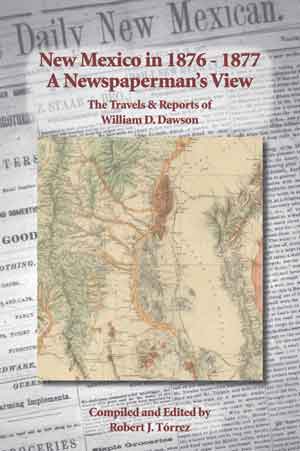The Travels & Reports of William D. Dawson
compiled and edited by Robert J. Torrez
128 pages, 3 maps
$27.95 hardcover (ISBN 1-890689-19-3)
$15.95 softcover (ISBN 1-890689-50-6)


2007 FINALIST, NEW MEXICO BOOK AWARDS
2007 WINNER IN MEDIA/JOURNALISM CATEGORY, BEST BOOKS USA BOOK NEWS
Selected as 23rd Most Popular Southwest History on Amazon.com (11/19/08)

Ever wonder what New Mexico was like in the nineteenth century? In 1876, newspaperman William D. Dawson undertook a series of journeys that took him the entire length of the territory from the D&RG railhead near Fort Garland, Colorado, to the Mesilla Valley and west to the mines of Silver City and Pinos Altos, New Mexico. Here for the first time in print since they appeared in the pages of The Santa Fe Daily New Mexican nearly a century and a half ago, are descriptions of New Mexico’s towns, its agriculture, wineries and mines; farmers, merchants, vintners, miners, soldiers, Indians, outlaws, and pretty girls—all the elements that we imagine constituted this great frontier—drew Dawson’s attention and found their way into his reports, leaving us an extraordinary portrait of New Mexico as it was mas antes, in the old days.
AUTHOR INFO: Robert J. Tórrez was the State Historian at the New Mexico State Records Center and Archives in Santa Fe from 1987 until his retirement in December 2000. Born and raised in the northern New Mexico community of Los Ojos, he has contributed to several books and published more than one hundred scholarly and popular articles on various aspects of New Mexico history and culture in New Mexico Historical Review, New Mexico Magazine, True West, Tradición Revista and other regional and national publications. His monthly column, “Voices From the Past” appears in Round the Roundhouse, the state government employees newspaper. His previous book, UFOs Over Galisteo and Other Stories of New Mexico’s History, was published in 2004.
REVIEWS:
MIDWEST BOOK REVIEWS
Compiled and edited by Robert J. Torrez (State Historian at the New Mexico State Records Center and Archives in Santa Fe from 1987 until his retirement in December 2000), "New Mexico In 1876-1887: A Newspaperman's View" is a collection of travelogs and reports by William D. Dawson when he undertook a series of journeys that took him through New Mexico. He embarked upon the D&RG railroad near Fort Garland, Colorado and traveled through the Mesilla Valley, going west to the mining towns of Silver City and Pinos Altos, New Mexico. His reports were published in 'The Santa Fe Daily New Mexican' and provided his readers with informative eyewitness descriptions of New Mexico's towns, agriculture, wineries, mines, farmers, merchants, vintners, miners, soldiers, Native Americans, outlaws, and pretty girls. "New Mexico In 1876-1887" is a unique contribution to the growing body of literate on the 19th Century American West and is especially recommended for academic library American History reference collections in general, and New Mexico State History reading lists in particular.-- MidWest Book Reviews, August 2007
In 1876-1877, William D. Dawson, a writer for The Santa Fe Daily New Mexican, composed a series of journalistic essays based on his travels through the New Mexico territory. His journeys took him to villages, farms, mines, Army posts and other locations that defined a region that would not be granted statehood until almost four decades later. Robert Torrez, who was the state historian at the New Mexico State Records Center and Archives from 1987 to 2000, has compiled and edited Dawson's accounts to present a fascinating and insightful portrait of New Mexico as it was 130 years ago.
Dawson's narratives describe his encounters with a variety of frontier personalities--the merchants, farmers, soldiers, outlaws and hardy frontier women who called the vast open landscape home. His travels would eventually encompass the entire length of the Rio Grande, from the San Luis Valley to Mesilla and west to Silver City and Tierra Amarilla. The most striking aspects of Dawson's accounts are his descriptions of the majestic natural scenery and the stoic, entrepreneurial spirit of the inhabitants of these lands.
However, as Torrez points out, Dawson's intended readership was mainly prospective emigrants from the eastern United States; consequently, he devotes special attention to Anglo-American contributions and exploitation of the region, often to the exclusion of the Hispanic participation. Only rarely does he address his attention to the significant influence of Hispanic culture and activity. This underlying attitude of minimizing Hispanic presence in contrast to "American energy and enterprise," as Dawson describes it, provides another kind of insight into the attitudes prevalent in New Mexico during this time. Despite Dawson's somewhat ethnocentric viewpoint, his reports provide an illuminating account of the changing New Mexico environment during the late 1870s. Torrez's compilation adds another perspective to the understanding of how New Mexico developed during this crucial time in its past and will interest both casual readers and scholars of state history.-- La Herencia Magazine, Summer 2007
In December 1876 The Daily New Mexican newspaper, in Santa Fe, sent one of their reporters on a nine-week trip to southern New Mexico to file dispatches on his observations, which were subsequently printed in the paper. In September 1877, he took a similar trip throughout northern New Mexico, Placed in context with contemporary promotional literature encouraging settlement of New Mexico by citizens from other parts of the country and immigrants—actually the relative dearth of such material—Dawson’s submissions were important in that they provided current information on New Mexico’s communities, industries, forts, residents, and geographic features. They are as interesting to read today as encapsulations of New Mexico history.
Dawson’s articulate images of the string of communities along the Rio Grande in southern New Mexico are picturesque: the villages of Alamosito, La Joya, Rio Puerco, Polvadera, Soccoro, San Antonio, San Marcial, and others are described. The Jornada del Muerto (Journey of Death), the desert stretch of El Camino Real basically from Socorro to Las Cruces, is covered in good detail. Dawson and his party visited Fort McRae, Fort Selden, and Fort Cummings, and he portrays the Mesilla Valley as the “garden spot of New Mexico.”
Dawson’s impressions of his northern New Mexico trip are equally detailed, even including a chemical analysis of the mineral spring water at Ojo Caliente. He describes how the Taos Valley was impacted by a two-year grasshopper infestation.
The author is well-known to northern New Mexico as the former state historian at the New Mexico State Records Center and Archives, and author of UFOs Over Galisteo and Other Stories of New Mexico’s History (UNM Press, 2004). Rio Grande Books, an imprint of LPD Press, is a regional publishing company featuring books on Southwestern history and culture. -- New Mexico Magazine, March 2007
WHAT PEOPLE ARE SAYING ABOUT THIS BOOK: “Just before the railroads came to New Mexico territory, the Santa Fe Daily New Mexican printed a running account of their reporter’s travels up and down the Rio Grande from the San Luis Valley to Mesilla and west to Silver City and Tierra Amarilla. Lively sketches of the countryside, the towns, farms, wineries, army posts and even spas at the hot springs all found a place in his dispatches. Casual readers and historians alike are indebted to Robert Tórrez for bringing these scenes of New Mexico some 130 years ago, not to be missed, to a modern audience.” —John P. Wilson, historian

